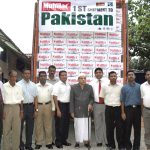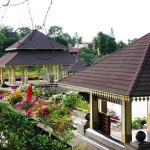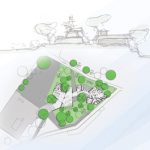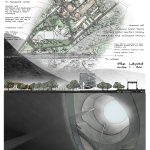
Among the younger and contemporary architects who follow in the footsteps of the forefathers–who built with sensitivity to earth–yet search for authenticity and truthfulness through modern architecture, is Sunil Gunawardana. He stands out as one of the most exceptional and truthful at this moment of time. His architecture is one of sincerity, emanating from a reverence to mother earth and a deep-seated understanding of the gratitude we owe to her for nourishing life in her bosom, and making it all possible for us to both build and dwell.
By Ranjith Dayaratne
When Sunil Gunawardana was commissioned to build a series of visitor centres in the Wasgamuwa National Park located in the North Central region, the challenge was clear. How would one build a building in the midst of the thick jungle without destroying the natural habitat of the fauna and flora of the region?
Wasgamuwa Park located in the District of Matale at a distance of 225 km away from Colombo spans over 36,900 hectares and is bordered by the Mahaweli Ganga and Amban Ganga rivers from the east and west. It is home to a tropical dry mixed evergreen forest characterised by tall trees. Local trees such as Weera, Palu, Wa, Ehala, Buruta, and the endemic Galsiyambala, Milla and Kaluwara are in abundance there which needed to be given their fair share to survive. Wasgamuwa is also home to 143 species of birds including the endemic Red-Faced Malkoha and Ceylon Jungle Fowl.
Sunil spent long hours wandering around the park and discovered that remains of a number of small rainwater reservoirs and ruins of temples within the park which revealed that the region was once home to prosperous villages. The ruins estimated to be about 1800 years old included a reclining Buddha statue at Buduruwayaya. Ruins of a palace with stone pillars had been found in an island in a canal known as Kalinga Yoda Ela built by King Parakrambahu the great in the twelfth century.
The huts on trees enabled to keep vigil over the ground… Sunil wanted nothing more than this experience to be offered to visitors.
Thus the design task was a tall order. The green jungles told him that his architecture was not wanted there unless he could build in complete harmony with the jungle. As R L Spittle, who wrote ‘The Village in the Jungle’ said, the village did not impose upon the jungle; rather it ennobled the jungle and acceded to its power. The farmers thus knew how to build, without antagonising this great power, which we now are trying to pacify through a plethora of theories of practices under the guise of sustainability. Allowing the greens to remain green and enabling them to become more green is the strategy of the farmer who knows little of sustainability except to build simple huts from natural materials. The huts are everywhere; on the ground, on the edges of paddy fields, and plantations and on tops of trees if that helped the villagers to take care of themselves while taking care of the environment. Thus Sunil conceived the project as a series of simple farmer huts elevated above the ground atop the trees.
The huts on trees enabled to keep vigil over the ground, and that was metaphorical of what the visitors would want to do in the forest. The vigilant gaze of the farmer falls upon the lush green of the paddy fields from the tree top hut and Sunil wanted nothing more than this experience to be offered to visitors. His design presents this relationship through architecture and also treats the jungle gently. The appearance of a series of glass roofs elevated upon timber decks rising through the lush greenery would leave it undisturbed, while enabling the visitors to experience nature. Man and nature, could still co-exist one nourishing the other.
Sustainability indeed is a catch phrase. Although theoreticians will articulate it in so many words and diagrams what is required is a deep understanding, rather than analysis, and a commitment to be truthful rather than passing academic interest. Borrow from nature, build simple and produce minimal transformations. That is the key to co-exist with earth.
Sunil Gunawardana’s architecture takes shape through committed efforts to stay above ground, disturbing the natural forest as minimally as possible.
Not a single tree was cut, he says, and walkways of the ants on the ground remain untouched.
The open buildings above ground also create a cool atmosphere, harnessing natural cross ventilation with a gust of wind that blows across the valley. Open decks extend out from the buildings onto the surrounding environment allowing the visitors to enjoy the jungle at night while gazing at the stars up above. The large open decks, and open toilets with courtyards have been positioned to enable the visitor to be with the jungle space even while being inside.
One could either say that there is no landscaping here or there is very careful landscaping – unobtrusive and complementary to the jungle.
The buildings have been elevated upon concrete columns and concrete beams and finished with a wooden deck. The roof’s, all-wood structure, is covered in corrugated aluminum cover. The decision to bring such artificial materials lie in the understanding of nature itself. As Spiittle wrote in the book ‘village in the jungle’, Sri Lanka’s jungles are beautiful, and fragile but simultaneously ferocious. Leave a building unattended for some time and nature will overwhelm the building. Thus for a building to remain there wrapped in nature, it needs to be able to withstand the ferocity of the jungle itself. Geoffry Bawa at the Kandalama hotel did precisely the same by erecting the structure in concrete and then allowing the Jungle to grow over. Any other material would be eaten up and destroyed in a matter of months.
Sunil Gunawardana’s aim of the design was to create a setting which sits in harmony with the natural context where animals, birds and insects would not have to change their ways to exist around the structures, albeit a little. Sustainability was not analyzed and talked about but achieved, by being simple and robust. The greens of the jungles have been allowed to go green. One could either say that there is no landscaping here or there is very careful landscaping – unobtrusive and complementary to the jungle. Indeed, it is the wilderness itself, carefully tended to and allowed to take charge of the setting that makes this a building that touches the earth gently. An adventure in the wild, it makes a sensitive architectural intervention in creating a memorable place in the bewildering forest.


















